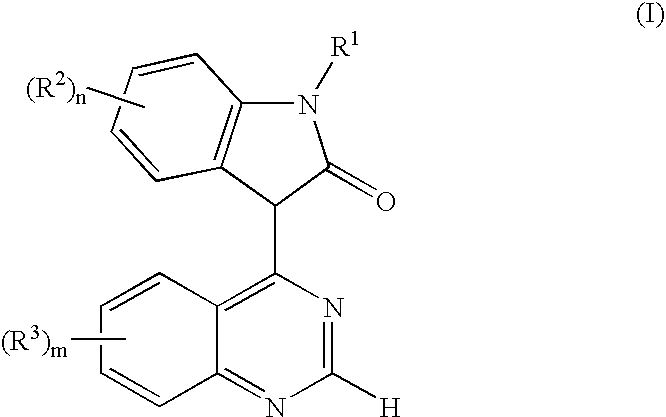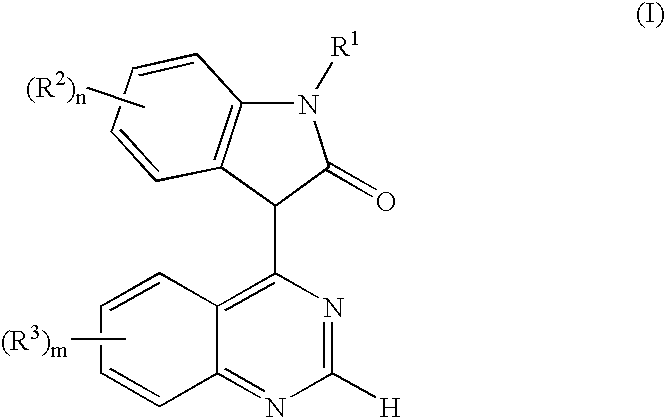Use of oxindole derivatives in the treatment of dementia related diseases, alzheimer's disease and conditions associated with glycogen synthase kinase-3
a technology of glycogen synthase and oxindole, which is applied in the field of oxindole derivatives, can solve the problems of lithium intoxication, the back of axons and neuritis, and the decline of axons
- Summary
- Abstract
- Description
- Claims
- Application Information
AI Technical Summary
Problems solved by technology
Method used
Image
Examples
example 1
7-(2-Morpholin-4-yl)ethoxy)-3H-quinazolin-4-one
A mixture of sodium hydride (12.7 g, 0.317 mol, 60% oil dispersion) and dimethyl sulfoxide (60 mL, 0.84 mol) was heated at 75° C. After 30 min the hydrogen gas evolution had ceased and the reaction was cooled to room temperature.
4-(2-Hydroxyethyl)morpholine (48 mL, 0.40 mol) was added portionwise to the reaction mixture. After stirring for 30 min, 7-fluoro-3H-quinazolin-4-one (13.0 g, 79.2 mmol; described in Rewcastle G. et al J. Med. Chem, 1996, 39, 4, 918-928) was added and the reaction solution was heated for 3 h at 150° C. The reaction mixture was cooled to room temperature and the resulting syrup was dissolved in ethyl acetate (500 mL) and triturated with diethyl ether (2 L). The solid was filtered off under a nitrogen atmosphere and washed several times with diethyl ether to obtain the crude product as a powder. The crude product was purified by flash chromatography (500 g silica gel column topped with a layer of celite) using...
example 2
4-Chloro-7-[(2-morpholinyl)ethoxy]quinazoline
Oxalyl chloride (4.55 mL, 52 mmol) was added dropwise to a suspension of 7-(2-morpholin-4-yl)ethoxy)-3H-quinazolin-4-one (11.9 g, 43.3 mmol) in methylene chloride (175 mL) followed by dropwise addition of N,N-dimethylformamide (1.5 mL). The reaction mixture was heated for 2 h at reflux. The solvent was removed in vacuo and the resulting solid was triturated with diethyl ether. The pale yellow solid was filtered off under nitrogen atmosphere to give 17.2 g (99% yield) of the title compound as a pale yellow powder: MS (AP+) mz / z 294.0 (M++1).
example 3
2-Hydroxy-3-[7-(2-morpholin-4-ylethoxy)quinazolin-4-yl]-1H-indole-5-carbonitril dihydrochloride
Sodium hydride (490 mg, 12.2 mmol, 60% oil dispersion) was washed with petroleum ether (2×10 mL) and dried under vacuum anrd the obtained material was suspended in anhydrous N,N-dimethylformamide (5 mL) and 5-cyanooxindole (323 mg, 2.04 mmol) in N,N-dimethylformamide (3 mL) was added. The resulting suspension was stirred for 30 min at room temperature and 4-chloro-7-[(2-morpholin-4-yl)ethoxy]quinazoline (200 mg, 0.68 mmol) in N,N-dimethylformamide (5 mL) was added. The reaction mixture was stirred for 1 h at room temperature. The reaction was quenched with aqueous hydrochloric acid (5 mL, 1 M) and N,N-dimethylformamide was removed in vacuo. To the resulting syrup was added water (50 mL) and the mixture were stirred vigorously. The solid formed was filtered off and dried at 70° C. under vacuum over night. The crude product was refluxed in methanol for 15 min and the insoluble material was...
PUM
| Property | Measurement | Unit |
|---|---|---|
| elongation | aaaaa | aaaaa |
| affinity | aaaaa | aaaaa |
| therapeutic concentrations | aaaaa | aaaaa |
Abstract
Description
Claims
Application Information
 Login to View More
Login to View More - R&D
- Intellectual Property
- Life Sciences
- Materials
- Tech Scout
- Unparalleled Data Quality
- Higher Quality Content
- 60% Fewer Hallucinations
Browse by: Latest US Patents, China's latest patents, Technical Efficacy Thesaurus, Application Domain, Technology Topic, Popular Technical Reports.
© 2025 PatSnap. All rights reserved.Legal|Privacy policy|Modern Slavery Act Transparency Statement|Sitemap|About US| Contact US: help@patsnap.com



